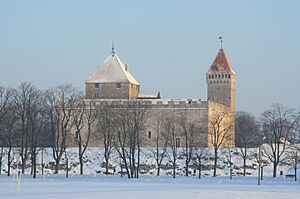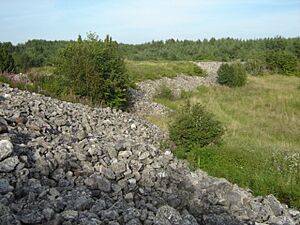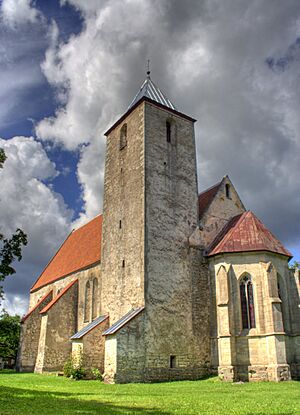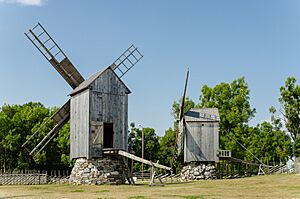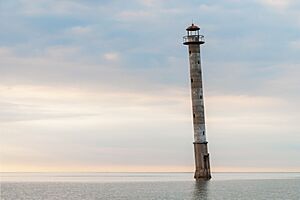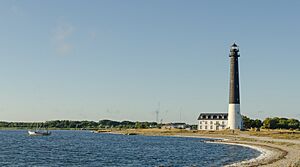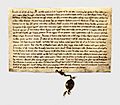Saaremaa facts for kids

Location of Saaremaa in Estonia
|
|
| Geography | |
|---|---|
| Location | Baltic Sea |
| Coordinates | 58°25′N 22°30′E / 58.417°N 22.500°E |
| Archipelago | West Estonian archipelago |
| Area | 2,673 km2 (1,032 sq mi) |
| Administration | |
| County | Saare County |
| Demographics | |
| Population | 31,357 |
| Pop. density | 11.7 /km2 (30.3 /sq mi) |
Saaremaa is the largest island in Estonia. It covers an area of about 2,673 square kilometers. This makes it a bit smaller than the country of Luxembourg. The island is located in the Baltic Sea. It lies south of Hiiumaa island and west of Muhu island. Saaremaa is part of a group of islands called the West Estonian Archipelago.
The highest point on Saaremaa is 54 meters above sea level. One very special place on the island is the Kaali crater. This crater was formed by a meteorite hitting the Earth. Saaremaa has many forests. The juniper tree is a common sight and a symbol of the island.
Contents
Discovering Saaremaa: Estonia's Largest Island
Saaremaa is a beautiful island with a rich history and unique nature. It is a popular place for both locals and tourists to visit. The island offers many exciting things to see and do.
What Makes Saaremaa Special?
Saaremaa is known for its diverse landscapes. You can find sandy beaches, tall cliffs, and dense forests. The island's nature is well-preserved. It is home to many different plants and animals.
The Kaali Meteorite Crater
One of the most famous natural wonders is the Kaali crater. This is a group of nine meteorite craters. The largest one is nearly circular. It is about 110 meters wide and 22 meters deep. Scientists believe the meteorite hit Earth around 3,500 years ago. This event created a small lake in the main crater. It is a fascinating place to learn about space and geology.

Panga Cliff: A Natural Landmark
The Panga Cliff is another impressive natural site. It is located on the northern coast of Saaremaa. The cliff rises up to 21 meters above sea level. It offers amazing views of the Baltic Sea. People often go there to watch the sunset. It is also a great spot for birdwatching.
Exploring Saaremaa's History and Culture
Saaremaa has a long and interesting past. It has been home to many different groups of people. This history can be seen in its castles, churches, and museums.
Kuressaare Castle: A Medieval Fortress
The most famous historical building is Kuressaare Castle. This medieval castle was built in the 14th century. It is one of the best-preserved castles in the Baltic region. Today, it houses the Saaremaa Museum. The museum tells the story of the island's history.
Ancient Strongholds and Churches
Saaremaa also has remnants of ancient strongholds. The Valjala Stronghold is an example of an old fort. These places show how people lived and defended themselves long ago. The island is also home to many old churches. Churches like Valjala Church and Kihelkonna St. Michael's Church have stood for centuries. They are important parts of the island's heritage.
Traditional Life and Windmills
To learn about traditional island life, you can visit places like the Mihkli Farm Museum. This museum shows what a typical farm looked like in the past. Saaremaa is also known for its windmills. The Angla Windmills are a group of traditional wooden windmills. They are a symbol of the island's rural charm.
Nature and Wildlife on Saaremaa
Saaremaa's nature is very diverse. It has many different habitats. These include coastal areas, forests, and wetlands.
Flora: Plants of the Island
The island is famous for its juniper trees. These evergreen shrubs grow widely across the island. You can also find many types of orchids. Saaremaa has more orchid species than any other place in Estonia.
Fauna: Animals of Saaremaa
Saaremaa is home to various animals. You might spot red deer in the forests. Many bird species also live on the island or stop there during migration. The coastal areas are important for seals.
Getting Around and What to Do
Saaremaa is connected to the mainland by a ferry. The main town is Kuressaare. It is a lively place with shops, restaurants, and hotels.
Activities for Visitors
Visitors can enjoy many activities. These include cycling, hiking, and swimming. The island's quiet roads are great for bike rides. The beaches are perfect for relaxing on sunny days. You can also explore the lighthouses, like the Kiipsaare Lighthouse or the Sõrve Lighthouse.
Images for kids
-
Shore of Saaremaa, by Estonian artist Konrad Mägi (1913–1914).
See also
 In Spanish: Saaremaa para niños
In Spanish: Saaremaa para niños




